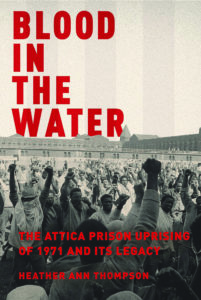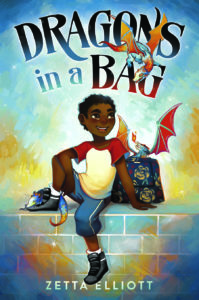Our picks for books, videos, websites, and other social justice education resources 33.1
Curriculum
Blood in the Water: The Attica Prison Uprising of 1971 and Its Legacy
By Heather Ann Thompson
(Vintage Books, 2016)
724 pp.

The Attica Prison Uprising, which took place in 1971, doesn’t make it into most high school history textbooks, but it should. Heather Ann Thompson’s book Blood in the Water provides a comprehensive history of the uprising — its causes, a moment-by-moment account of the four days in which prisoners held hostages and negotiated for more humane prison policies, a searing account of the horrifyingly violent retaking of the prison by law enforcement, and a damning indictment of the institutional cover-up that followed and persists until this day. Attica’s prisoners were denied water, food, soap, toilet paper, healthcare, newspapers, books, and fresh air, and were subject to brutal harassment and violence, disproportionately inflicted upon Black and Brown men. These are conditions that persist for many of the United States’ 2.2 million prisoners today. Any teacher wanting to address criminal justice and prison reform in their classes would do well to take a look at the history of Attica.
***
Warning from My Future Self
Story by Jean Tepperman
Art by Alfred Twu
(Sunflower Alliance, 2017)
(Available for free online at www.sunflower-alliance.org/warning-from-my-future-self/)
34 pp.

Warning from My Future Self is part dystopian story, part call to action about the threat of climate change and the need for young people to act, and act now. Written in a comic book/graphic novel format, the booklet is set in Oakland, California. Sixteen-year-old Gabe Sanchez visits his life 50 years into the future, and it’s not a pretty picture: monster fires, unprecedented heat waves, hyper-segregation, increased crime, racist police violence, poverty, hunger, family fragmentation, homelessness, water shortages. But it is not an inevitable future, and Tepperman offers glimpses of an attractive alternative — one that begins today with the activism of young people. No doubt, the booklet is polemical and without a lot of nuance. But it’s a welcome addition to the literature that can be used to educate middle and high school students about the urgency of the climate crisis and the activism required of us all.
Policy
Miseducating for the Global Economy
By Gerald Coles
(Monthly Review Press, 2018)
256 pp.

As inequality yawns wider and wider in the United States, the corporate elites who benefit from this inequality need to find ways to justify why they have so much and others so little. As Gerald Coles argues in his valuable new book, “A dominant answer for corporations and their political surrogates has been that U.S. public schools are primarily to blame because they have failed potential employees in the face of the 21st-century global economy. Though many new kinds of jobs requiring science, technology, engineering, and math (STEM) skills have been created, schools are criticized for not teaching these skills to enough students.” Coles dismantles the vision of schooling celebrated by corporations that schools should prepare children for “a world of perpetual competition.” He shows that this glib prescription quickly becomes a hammer of blame when, inevitably, not all children succeed in the cutthroat arena of global capitalism. Miseducating for the Global Economy helps us read and resist the prevailing vision of school reform.
Upper Elementary Books
Dragons in a Bag
By Zetta Elliott
Illustrated by Geneva B
(Penguin Random House, 2018)
160 pp.

Set in gentrifying Brooklyn, Dragons in a Bag is about a young boy (Jax) who spends the day with an elderly neighbor (Ma) while his mother goes to court to challenge their eviction. To Jax’s surprise, Ma is a witch who needs his help on a mission to deliver three young dragons to another realm. He agrees. No spoilers here. Just be warned that readers will anxiously await the sequel. Elliott explains that she wrote the book because “The fantasy fiction I read as a child offered an escape from my own reality, but it didn’t provide the tools I needed to theorize my own experience. I wanted the urban students I taught to know that magic can happen to anyone, anywhere — not just white kids in a castle in England.”
***
This Promise of Change: One Girl’s Story in the Fight for School Equality
By Jo Ann Allen Boyce and Debbie Levy
Illustrated by London Ladd
(Bloomsbury, 2019)
228 pp.

Did you know that one year before the Little Rock Nine, in Clinton, Tennessee, 12 Black students desegregated their high school? Their dramatic story is told by one of the 12 students — Jo Ann Allen Boyce — in collaboration with children’s book author Debbie Levy. They use free verse interspersed with quotes from newspapers, white supremacist protest signs, preachers’ sermons, and other primary documents from the time. Through the voice of Jo Ann, the reader learns of the strength of the Black community and how much is sacrificed and risked by the Black students to go to the previously all-white high school. The white community riots, which leads to the National Guard being sent to Clinton for the month of September. The Klan also has a strong presence. One entry from the book reads: “Wednesday September 26, When word comes the Ku Klux Klan is driving up the Hill, my father gets his gun. We live here. He won’t run. . . . When word comes my dad’s in jail — my dad! And not the bombers! His crime? There’s only one: A black man with a gun.” Highly recommended for grades 7+.
Film
Columbus in America
Directed by Paul Puglisi
(Pug Media, 2018)
Available on iTunes, Amazon, and Google Play
89 min.
This is the best and most comprehensive film on the history of Columbus — and the uses and abuses of the so-called discovery of America. It is a story of racist violence and unspeakable cruelty. But it is also the strange story of how this mission of colonial conquest was appropriated as a day of Italian pride, a defiant yet sad assertion that “We’re American, too.” Columbus in America explores the history of what transpired in 1492 and after, and how “Columbus” has been used throughout U.S. history to legitimate the marginalization of Indigenous peoples. However, the film is ultimately hopeful, as it focuses on how the victims of Columbus and those who came after have themselves targeted “Columbus in America” to assert their humanity, their history, and their rights. The film is too long for most classroom uses, but there are lots of excerpts that could be used effectively.
Website
Alliance for Climate Education
acespace.org

The Alliance for Climate Education sets out to “educate young people on the science of climate change and empower them to take action . . . within a frame of justice and optimism.” Their website offers a trove of resources: ways for students to join a Youth Action Network, ideas for student activism, lesson plans, classroom-friendly videos. Many of these are short, poignant videos on the effects of climate change and fossil fuels on young people throughout the United States. These focus on them as activists, not only as victims. Sarah in Sanford, North Carolina, organizes against the permitting of a coal ash dump in her community; Amira responds to the disaster wrought by Hurricane Maria in Puerto Rico, distributing fruit trees and seeds to low-income families in the rural Barranquitas region; Celeste in Reno, Nevada, describes the drought-depleted Truckee River, and school-based water conservation measures she has organized. These and others can be used in elementary through high school classrooms.

